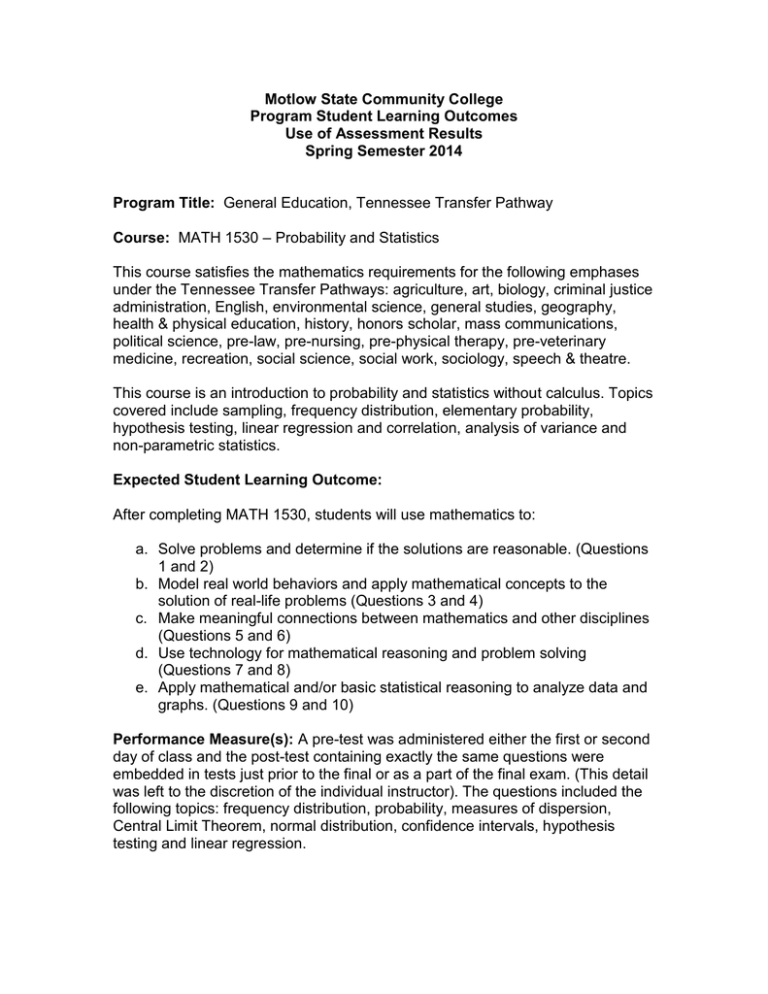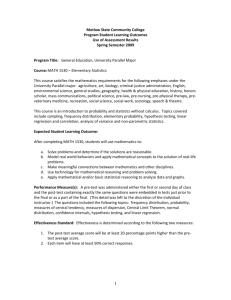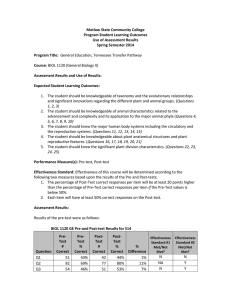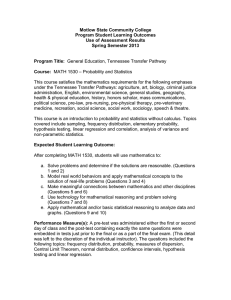Motlow State Community College Program Student Learning Outcomes Use of Assessment Results
advertisement

Motlow State Community College Program Student Learning Outcomes Use of Assessment Results Spring Semester 2014 Program Title: General Education, Tennessee Transfer Pathway Course: MATH 1530 – Probability and Statistics This course satisfies the mathematics requirements for the following emphases under the Tennessee Transfer Pathways: agriculture, art, biology, criminal justice administration, English, environmental science, general studies, geography, health & physical education, history, honors scholar, mass communications, political science, pre-law, pre-nursing, pre-physical therapy, pre-veterinary medicine, recreation, social science, social work, sociology, speech & theatre. This course is an introduction to probability and statistics without calculus. Topics covered include sampling, frequency distribution, elementary probability, hypothesis testing, linear regression and correlation, analysis of variance and non-parametric statistics. Expected Student Learning Outcome: After completing MATH 1530, students will use mathematics to: a. Solve problems and determine if the solutions are reasonable. (Questions 1 and 2) b. Model real world behaviors and apply mathematical concepts to the solution of real-life problems (Questions 3 and 4) c. Make meaningful connections between mathematics and other disciplines (Questions 5 and 6) d. Use technology for mathematical reasoning and problem solving (Questions 7 and 8) e. Apply mathematical and/or basic statistical reasoning to analyze data and graphs. (Questions 9 and 10) Performance Measure(s): A pre-test was administered either the first or second day of class and the post-test containing exactly the same questions were embedded in tests just prior to the final or as a part of the final exam. (This detail was left to the discretion of the individual instructor). The questions included the following topics: frequency distribution, probability, measures of dispersion, Central Limit Theorem, normal distribution, confidence intervals, hypothesis testing and linear regression. Effectiveness Standard: Effectiveness is determined according to the following two measures: 1. The post-test average score will be at least 20 percentage points higher than the pre-test average score. 2. Each item will have at least 50% correct responses. Results of the pre-test were as follows: Expected SLO a a b b c c d d e e Question Missed Correct %Missed % Correct 1 2 3 4 5 6 7 8 9 10 89 100 98 92 98 90 95 75 99 84 33 22 24 30 24 32 27 27 23 38 73% 82% 80% 75% 80% 74% 78% 61% 81% 69% 27% 18% 20% 25% 20% 26% 22% 39% 19% 31% Results of the post-test were as follows: Expected Question SLO a a b b c c d d e e 1 2 3 4 5 6 7 8 9 10 Missed Correct % Missed % Correct 21 36 25 57 50 41 23 13 25 14 101 86 97 65 72 81 99 109 97 108 17% 30% 20% 47% 41% 34% 19% 11% 20% 11% 83% 70% 80% 53% 59% 66% 81% 89% 80% 89% Change In Percentage Points +56 +52 +60 +28 +39 +40 +59 +50 +61 +58 122 students completed the pre-test and post-test. 1. Assessment results showed a 50.3 percentage point gain from pre-test to post test, as the average of pre-test scores was 24.7and the average of the post-test was 75.0 2. Post-test data from item analysis indicate that greater than 50% of students responded correctly on all post-test questions, except question 2. Ninety-three students took both the pre-test and post-test. The average of the pre-test scores was 24.7% and the average of the post-test scores was 75.0%. Assessment results showed a 50.3 percentage point gain from pre-test to posttest, thus meeting the effectiveness standard that the post-test average score must be at least 20 percentage points higher than the pre-test average score. The effectiveness standards states that each item will have at least 50% correct responses on the post-test. This standard was met by all problems. Use of Assessment Results: During this pre/post-test, a change was made with one of the Student Learning Outcome d - Use technology for mathematical reasoning and problem solving. From the analysis reports from 2009, 2011, 2012, 2013 and 2014, we can see the following MATH 1530 Change in Percentage Points 70 60 50 2009 2011 40 2012 30 2013 2014 20 10 0 a b c d e Student Learning Outcomes From the chart, the change in percentage points is the highest it has been in almost every Student Learning Outcome. This will also be discussed at the next Mathematics Department meeting in August 2014.





